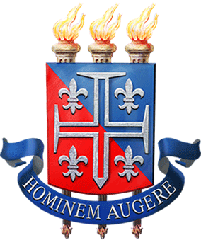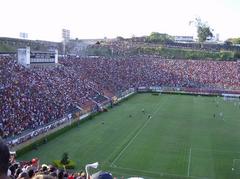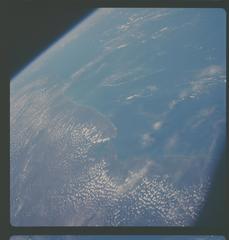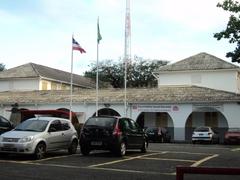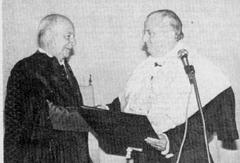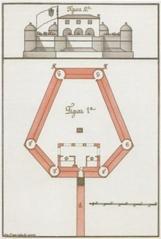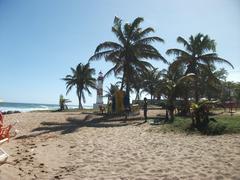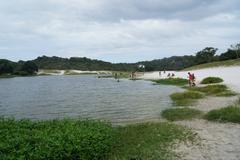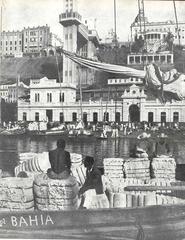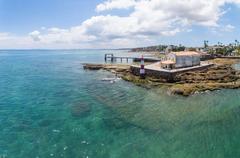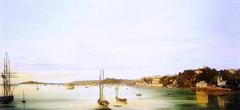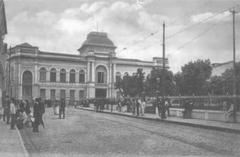
Forte de São Diogo Visiting Hours, Tickets, and Complete Guide to Salvador’s Historical Sites
Date: 04/07/2025
Introduction
Forte de São Diogo is an enduring symbol of Salvador’s colonial past and maritime defense. Strategically perched in the Barra district, this 17th-century fort stands as both a powerful historical monument and a vibrant cultural venue. Visitors are treated to panoramic views of Baía de Todos os Santos, immersive art experiences, and a tangible connection to Brazil’s rich colonial legacy. Whether you are a history buff, art lover, or simply seeking a scenic spot for sunset, this comprehensive guide will ensure you make the most of your visit.
(bahia.ws)
(bahia-turismo.com)
(pt.wikipedia)
Table of Contents
- Historical Overview
- Architectural Highlights
- Visiting Hours and Tickets
- Accessibility and Facilities
- On-Site Experience and Attractions
- Travel Tips and Safety
- Nearby Sights and Suggested Itineraries
- FAQs
- Responsible Tourism
- Conclusion & Call to Action
- References
Historical Overview
Constructed in the early 17th century, Forte de São Diogo emerged from the urgent need to defend Salvador after the Dutch invasion of 1624. Its position at the base of Morro de Santo Antônio was chosen for a commanding view over Porto da Barra and the Bay of All Saints, safeguarding the city’s vital maritime routes (colonialvoyage.com). Over time, the fort became a crucial link in a defensive chain, working alongside Forte de Santa Maria and Farol da Barra to shield Salvador from further attacks.
Throughout the 17th and 18th centuries, renovations strengthened the fort’s artillery and walls, culminating in the multi-bastion, Portuguese-Italianate structure visitors see today. Its architecture and history are intertwined with Salvador’s evolution as Brazil’s first colonial capital and a major Atlantic port (bahia.ws). Today, the fort serves not only as a monument but also as a cultural bridge, fostering public memory and artistic expression.
Architectural Highlights
Layout and Construction
- Irregular Polygonal Plan: The fort’s distinctive design follows the contours of the hillside, maximizing defensive coverage.
- Thick Masonry Walls: Built using local stone bonded with lime mortar, ensuring resilience against attacks and the elements.
- Bastions and Watchtowers: Offer overlapping fields of fire and panoramic observation points.
- Central Courtyard: Surrounded by vaulted chambers that once housed barracks and powder magazines.
- Restored Entrance: Features a coat of arms and a traditional sentry box, symbolizing the fort’s colonial heritage (bahia-turismo.com).
Adaptive Reuse
Since 2016, the fort has hosted the Espaço Carybé das Artes—an interactive art center celebrating the work of Carybé and Bahian cultural traditions. Restoration efforts have preserved historical features while introducing modern amenities for exhibitions and events (portal.iphan.gov.br).
Visiting Hours and Tickets
- Cultural Center: Open Tuesday through Sunday, 9:00 AM to 6:00 PM.
- Mirante Bistrô: Open Tuesday through Sunday, 3:00 PM to 10:00 PM.
- Entrance Fee: Modest admission at the door; discounts for students, seniors, and locals. Some art exhibitions may charge a supplemental fee.
- Ticket Purchase: Buy at the entrance; check the official website for current pricing and event-specific hours (pt.wikipedia; tourb.com.br).
Accessibility and Facilities
- Location: Praça Azevedo Fernandes, at Porto da Barra Beach, easily accessible by taxi or ride-hailing apps (braziloffbeat.com).
- Mobility: Partial accessibility with ramps and adapted pathways, but some historic areas have stairs and uneven surfaces.
- Facilities: Restrooms, shaded outdoor seating at the bistrô, and interpretive signage throughout the site.
On-Site Experience and Attractions
Historical Interpretation
- Guided Tours: Available by request, often led by staff in historic uniforms, providing context on the fort’s military and colonial history.
- Interpretive Panels: Offer detailed information in Portuguese and occasionally English.
Cultural Programming
- Espaço Carybé das Artes: Engaging digital installations and virtual reality experiences centered on Afro-Brazilian culture and the art of Carybé (topensandoemviajar.com).
- Art Exhibitions and Events: Regularly hosts music, dance, and cultural workshops.
Gastronomy
- Mirante Bistrô: Serves Bahian and international cuisine with specialty cocktails and sunset views over the bay (salvadordabahia.com).
Photography
- Views: The fort’s ramparts offer some of Salvador’s best vantage points for photographs, especially at sunset (lonelyplanet.com).
- Safety: Keep valuables secure and use a fanny pack or crossbody bag (livemoretravelmore.com).
Travel Tips and Safety
- Best Time to Visit: Weekdays or early mornings for fewer crowds; late afternoons for sunset.
- Dress Code: Light, breathable clothing; bring water, sun protection, and small cash for tips and purchases.
- Language: Portuguese is predominant; basic phrases or a translation app are helpful.
- Safety: Barra is generally safe, but remain vigilant, avoid isolated areas after dark, and use reputable transportation (livemoretravelmore.com).
Nearby Sights and Suggested Itineraries
- Forte de Santa Maria: Another historic fort with exhibitions and beach access (bahia.ws).
- Farol da Barra (Barra Lighthouse): Nautical Museum and city views (braziloffbeat.com).
- Porto da Barra Beach: Famous for calm waters and vibrant local life.
Suggested Itinerary: Visit Forte de São Diogo in the afternoon, explore the art center, have a meal at the bistrô, then walk along the waterfront to Farol da Barra for sunset.
Frequently Asked Questions (FAQ)
Q: What are the current visiting hours?
A: Cultural center: 9:00 AM–6:00 PM, Tuesday–Sunday. Mirante Bistrô: 3:00 PM–10:00 PM, Tuesday–Sunday.
Q: Is there an entrance fee?
A: Yes, a modest fee is charged at the door, with discounts for certain groups.
Q: Are guided tours available?
A: Yes, periodically; inquire at the ticket office or check event schedules.
Q: Is the fort accessible for wheelchair users?
A: Some areas are accessible, but others remain challenging due to historic stairs and terrain.
Q: What should I bring?
A: Sun protection, water, a camera, and small change for incidentals.
Responsible Tourism
Support local artists and businesses, respect the site’s historical significance, and minimize environmental impact by disposing of waste properly and using reusable water bottles. Engage respectfully with local communities and their traditions.
Conclusion & Call to Action
Forte de São Diogo is more than a historic fort—it is a living testament to Salvador’s resilience, creativity, and cultural vibrancy. Its fusion of military history, art, and stunning coastal scenery make it an unmissable destination. Plan your visit during the recommended hours, enjoy the art center and bistrô, and capture the magic of Salvador from its scenic ramparts.
For updated information, event schedules, and interactive tours, download the Audiala app and follow our social media channels. Make the most of your Salvador adventure—explore, learn, and be inspired by Forte de São Diogo.
References
- History of the Forts and Lighthouses of Salvador – Bahia.ws
- Forts in Salvador Bahia – Colonial Voyage
- Forte de São Diogo – Bahia Turismo
- Forte de São Diogo Entry – Portal IPHAN
- Forte de São Diogo Wikipedia (Portuguese)
- Defesas do Porto da Barra – Bahia.ws
- Salvador Travel Guide – Brazil Off Beat
- Forte de São Diogo Cultural Events and Reviews – Lonely Planet
- Salvador 475 Years: History of Forte de São Diogo – Bahiaja
- TourB – Forte de São Diogo
- Topensandoemviajar – Forte São Diogo
- Salvador da Bahia Official Tourism
- Live More Travel More – Salvador





